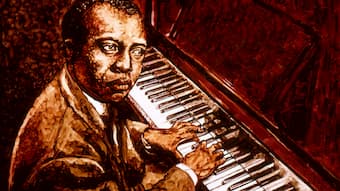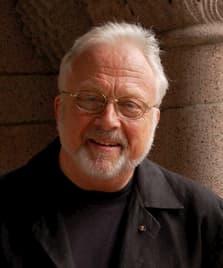
Painting of Scott Joplin by Don Locke © Studio Cline
Perhaps you have heard of Scott Joplin and one of his famous works, The Entertainer. Scott Joplin, known as the King of Ragtime, was one of the pioneers creating this American musical art form. Originally it not only referred to piano music but also instrumental, vocal works, and dance. The earliest published rags were in fact songs. Featuring syncopated rhythms, the structure of ragtime is associated with dances with duple or quadruple meters such as polka, two-step, and schottische. This style is recognized as a “general trait of African American music” and it is highly associated with black culture.1 Therefore, it was not welcomed and popularized until 1893, when it was brought to World’s Columbian Exposition in Chicago. Ragtime pioneers such as Scott Joplin (1868-1917) and Johnny Seamore presented their music there and since then, ragtime music was widely spread, and it was popular before the end of 1910s.
The introduction of jazz in the 1910s slowly replaced the popularity of ragtime in the 1920s and 1930s. In the 1940s, the first wave of ragtime revival “washed across American popular music.”2 This revival lasted for 30 years and in 1974, the ragtime pioneer Scott Joplin, was at the top of American pop and rock music charts, along with Paul McCartney and Stevie Wonder.3 This revival brought back the interest in Joplin’s music, as well as attracted composers to write ragtime music in a more modern fashion. William Bolcom was one of the academic composers who modernized ragtime music.
Education Background

© John Pollock / University of Washington
William Bolcom (May 26, 1938-) is a celebrated American Composer. Born in Seattle, Washington, his musical talent was developed at an early age. A student of Darius Milhaud (1892-1974) and Olivier Messiaen (1908-1992), Bolcom studied in Paris Conservatoire and he received a doctorate degree at Stanford University. He won many awards throughout his life. He received the Pulitzer Prize, National Medal of Arts, four Grammy awards. Bolcom had served in many professional positions before his retirement in 2008. He was appointed to be the visiting professor at the University of Washington, faculty member in Queens College of the City University of New York (CUNY), Composer in Residence at Yale University Drama School and New York University School of the Arts, and he spent most of his teaching career at the University of Michigan’s School of Music. One of Bolcom’s unique styles is to merge popular music into traditional classical music. His unique compositions brought him numbers of prestigious awards and one of his contributions, as well as one of his biggest interest, is the area of ragtime music.

© Discogs
Bolcom began to write ragtime music when he discovered some of the piano scores of Joplin’s works, including his opera Treemonisha in 1966. He believed “American music is simply not American music without black Influence.”4 Together with William Albright (1944-1998), they collaborated and wrote rags together. In Bolcom’s modernized rags, he combined different styles and gestures into his compositions, including the stride style learned from James Herbert Blake (1887-1983), known as “Eubie Blake.”
Three Periods of His Ragtime Compositions
Majority of his rags compositions were written between 1967 and 1993. His ragtime compositions can be divided into three periods. The first period included seven earliest rags; Three Classic Rags, Three Popular Rags and California Porcupine Rag, and they were all composed during 1967-1968. His earliest rags display the popular rag style of the 1910s, following the styles established by Scott Joplin, Louis Chauvin, and James Scott. For example, Glad Rag, the first piece of Three Classic Rags, was inspired by Joplin’s Treemonisha.5 The treatment of harmony, rhythm, and texture is similar to Joplin’s composition but Bolcom also added new elements in this work, such as Da Capo structure and the half-step modulation, which are rarely found in rags.

William Bolcom (1938-)
The second period, between 1969 and 1971, includes twelve rags and two famous rags, Graceful Ghost Rag from the suite Three Ghost Rags and The Serpent’s Kiss in the suite Garden of Eden, were both written during this period. This period represents the influence from Eubie Blake and his stride style. Eubie’s Luckey Day and Knight Hubert demonstrate many techniques borrowed from Blake. It also shows the expansion of musical complexity, incorporating twentieth-century compositional idioms into the traditional ragtime style. In The Serpent’s Kiss, Bolcom incorporated “new” elements in the piece. It is a rag fantasy with an expansion from the traditional ragtime structure.6 Through frequent changes of tempo, tonality, dynamics, texture, and musical expressions, each section contrasts with each other dramatically and effectively. Twentieth century compositional techniques like dissonance, tone clusters are used in this piece but more interestingly, Bolcom also included some theatrical effects such as footsteps, finger tappings and tongue clickings.
The so-called third period is comprised of three rags written after 1974. In this period, Bolcom’s rags are less complex and return to traditional ragtime format. For examples, in Raggin’ Rudi (1974) and Epithalamium (1993), they both resemble the classic rag style in many aspects, such as the uses of form, rhythm, and harmony.
Contribution and Influences
Through connecting classical and popular musical styles, Bolcom’s piano rags have successfully attracted classical pianists and are performed regularly at professional level. Ragtime music has inspired Bolcom not only to compose rags for piano, ragtime has also become part of his compositional idioms. In fact, Bolcom did not focus on composing rags after 1974 but ragtime idioms can still be found in his later works, such as the Twelve New Etudes for Piano (1977-1986), which was awarded Pulitzer Prize in 1988. His contribution to the revival of ragtime provides more sophisticated rag repertoire and extends the reach and influence of ragtime as quintessentially American music.
1 Edward A., Berlin, “Ragtime,” Grove Music Online, accessed 28 Oct. 2020.
2 Eric Charles Melley, “William Bolcom’s 3 Ghost Rags: An Orchestration for Chamber Ensemble with Commentary on the History and Propagation of Ragtime” (D.M.A paper, Arizona State University, 2013), 9.
3 The revival reached its peak in 1973 when the movie The Sting showcased Joplin’s rags and made his music famous again. See also ibid., 10.
4 William Bolcom, “Song and Dance,” in The Lives of the Piano, ed. James R. Gaines (New York: Holt, Rinehart and Winston, 1981), 157.
5 Yeung Yu, “A Style Analysis of William Bolcom’s Complete Rags for Piano” (D.M.A paper, University of Cincinnati, 2007), 47.
6 The form of this work is AA-B-Transition-A’-C-D- EE-A-Coda.
For more of the best in classical music, sign up to our E-Newsletter




